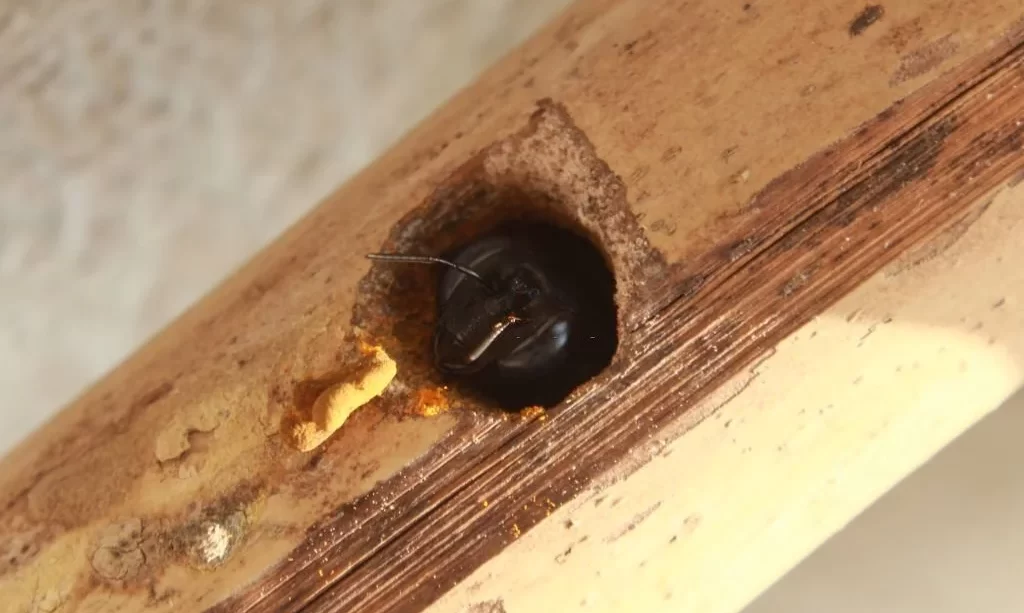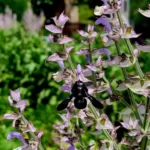Carpenter bees, often mistaken for bumblebees due to their similar appearance, exhibit a unique and intriguing nesting behavior that involves drilling holes into wood. This behavior has fascinated researchers and curious observers alike. In this guide, we’ll delve into the reasons behind why carpenter bees engage in this hole-drilling behavior and explore the intricacies of their nesting instinct.
- TERMITE KILLER: Kills the termites you see, and the ones you don’t see
- INSECT KILLER: Plus kills other wood-infesting insects including Carpenter Bees, Ants, Beetles, and more
- FOAM SPRAY: The foam expands at a 30:1 ratio to fill cracks
- EASY APPLICATION: Do it like the pros do- get the hard-to-reach areas with ease
Nesting Instinct
Wood as a Nesting Site: Carpenter bees are renowned for their preference for wood as nesting sites. Unlike many other bee species that nest in the ground or in plant stems, carpenter bees have a distinct affinity for wood, especially softwoods like pine, cedar, and redwood.
Protection for Offspring: The primary purpose of drilling holes into wood is to provide a secure and sheltered environment for their offspring. The female carpenter bee meticulously constructs galleries within the wood, where she lays her eggs. These galleries not only house the eggs but also serve as a source of pollen and nectar, ensuring the developing larvae have a consistent food supply.
Understanding the nesting instinct of carpenter bees sheds light on their fascinating behavior and their role in the natural world. By exploring the motivations behind their hole-drilling activities, we gain a deeper appreciation for these industrious insects and their unique nesting habits.
Creating Brood Chambers
Tunnels and Chambers: Carpenter bees are skilled architects when it comes to nest construction. They create tunnels within the wood, often branching off into smaller chambers.
Gallery Construction: The female carpenter bee uses her robust mandibles to bore into the wood, creating a network of galleries. Each of these galleries serves as an individual brood chamber where she lays an egg and provides a store of pollen and nectar as sustenance for the developing larva.
Protection from Predators
Natural Defense Mechanism: Carpenter bees drill deep into wood not only to establish their nests but also to protect their precious brood from potential threats, including birds and other insects.
Camouflaged Nests: By nesting within the wood, carpenter bees effectively conceal their young from view, making it challenging for predators to locate and access the larvae, thus increasing the chances of their survival.
The creation of brood chambers and the protective aspect of drilling holes into wood are essential components of carpenter bee nesting behavior. These actions contribute to the survival and thriving of their offspring, highlighting the intricate strategies employed by these remarkable insects.
Overwintering and Shelter
Surviving the Elements: Carpenter bees utilize their wood-boring abilities to establish overwintering sites. These sites are typically within existing tunnels or galleries in wood.
Protection from Harsh Weather: Overwintering within the wood provides carpenter bees with protection from the harsh winter weather conditions, allowing them to survive until spring.
Natural Behavior and Life Cycle
Cyclical Process: Carpenter bee drilling is an integral part of their natural life cycle. Each generation of carpenter bees continues this behavior, creating new tunnels and expanding existing ones.
Role of Males: Male carpenter bees, although unable to sting, play a vital role in the nesting process. They are often observed hovering near the entrances to protect the nests from potential threats.
Conclusion
Carpenter bees’ drilling of holes into wood serves multiple vital purposes in their life cycle. From creating secure brood chambers for their offspring to providing protection from predators and harsh weather, this behavior is a testament to their adaptability and survival strategies. Understanding the natural behavior and life cycle of carpenter bees allows us to appreciate their role in ecosystems and the fascinating ways in which they interact with their environment. While their wood-boring activities can sometimes lead to structural damage, carpenter bees also play essential roles in pollination and ecological balance, emphasizing the need for coexistence and conservation efforts.





